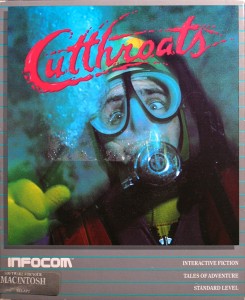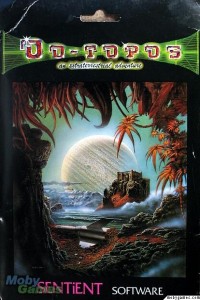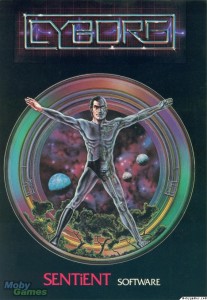Opinions amongst the former Imps vary wildly as to just how easy or difficult it was to work with ZIL, Infocom’s in-house adventure language. Stu Galley calls it “fairly easy”; Steve Meretzky calls it “quite intuitive” and “much easier to pick up” than any other programming language he had attempted before becoming an Imp; Bob Bates calls it “not that complicated,” at least for most tasks. Brian Moriarty, on the other hand, considers it “not particularly intuitive,” something that he learned only through sheer doggedness even as an accomplished assembly-language programmer (the skill which got him a job at Infocom in the first place). Some of those with less technical backgrounds found ZIL even more daunting. In early 1984 Infocom hired a prominent pop-science writer, who shall remain nameless, to become an Imp. Several other former Imps claim that, after he had struggled some six months with ZIL, they literally found him huddled beneath his desk, victim of a complete breakdown of sorts. That, needless to say, was that for him.
ZIL very nearly drove Mike Berlyn to the same state; he still considers actually becoming proficient with the language the biggest single accomplishment of his three years with Infocom. When he first came to the company, he regarded ZIL almost as a betrayal, the antithesis of what Marc Blank had promised him that working with their technology would be:
It was presented to me as, “We have this development system. Anybody can use it, and it’s just crying out for a writer. Why don’t you have a whack at it?”
That was not the case; it was not the truth. It wasn’t anywhere near reality. What they had was a high-level object-oriented language and a series of compilers, run-time interpreters, and virtual machines that were infinitely complex, and very little of it was hidden from the Implementer.
I was a self-taught programmer. I knew BASIC and some 6502 assembler. They sat me down in front of a terminal and said, “Here’s Emacs” — an editor I’d never used. I had no idea. To open a file took like fifteen keystrokes; I developed this claw from trying to press five keys at once. There was no language manual which I could sit down and go through, no tutorials or anything. And this was for any writer off the street? “Here you go, sit down at the terminal and write yourself a game!”
Even after becoming proficient at last, an endeavor he estimates to have required about six months, Berlyn continued to hate programming in the language. That loathing may be key to understanding something that must have driven his colleagues at least a little bit crazy about Mike Berlyn: hired on the basis of his novelist’s pedigree to be Infocom’s first “real writer” of interactive fiction, he always wanted to do anything but write interactive fiction. Of the three adventure games he wrote for Infocom, the only one he could be said to have tackled voluntarily and enthusiastically was the first, Suspended, a game which was arguably the least novel-like work Infocom would ever brand “interactive fiction,” being almost more a strategy game in text or a computerized board game. He had to be cajoled into doing Infidel, with his dissatisfaction showing up in the rather sour atmosphere of the final product. By 1984 he’d gotten involved with the research-and-development side of the company, working on a cross-platform graphics system and brainstorming with Marc Blank new-and-improved versions of Infocom’s core technologies of ZIL and the Z-Machine. He had also begun to design what would become the company’s first non-adventure game and first to use graphics, a multi-player computerized board game called Fooblitzky which would appear in 1985. (In light of Suspended and Fooblitzky, perhaps Berlyn was really a frustrated board-game designer slumming it as a writer?)
When a certain bestselling author by the name of Douglas Adams came to Infocom to propose a collaboration, he asked to work with Mike Berlyn by name. Berlyn turned the proposal down flat, saying he wasn’t interested in sharing power with another designer. With the highest-profile project Infocom would ever have hanging in the balance, Mike Dornbrook was left scrambling to enlist the ever-reliable Steve Meretzky for the project and to convince Adams that he could do just as good a job as the guy who wrote Adams’s favorite Suspended. I want to emphasize here that everyone liked Mike Berlyn, what with his big booming laugh and his knack for taking the piss out of everything in a good-natured way that kept everyone grounded: Suspended became Suspenders; Cornerstone became, prophetically as it would turn out, Tombstone; Choose Your Own Adventure books became What the Fuck Do I Do Now? books. But man, could it be hard to get and keep him on any given task.
Getting Berlyn to do another adventure game for 1984, even sans-Adams, was a challenge. A compromise was eventually reached: he would design the game and write the text, but would not be forced to program it. That should give him enough time to also continue with his other projects. For the actual programming, Infocom turned to one Jerry Wolper, an MIT computer-science graduate who had been doing various jobs for the company since 1982. This sort of development partnership was something that Infocom was grudgingly coming to accept as the only viable way of using writers-turned-Imps, as opposed to programmers-turned-Imps, to create interactive fiction; the science-writer fiasco would mark the last time they would just plant an outside writer in front of a terminal and hope for the best. Partnerships were in fact responsible for three of their five games of 1984, Berlyn’s among them.
The game in question is called Cutthroats. In an odd coincidence that probably wouldn’t have happened if the matrix had come into force a few months earlier, it was not only Infocom’s second “Tale of Adventure” in a row but also has a nautical theme superficially similar to that of the preceding game, Seastalker. You play a down-on-the-luck treasure diver living on Hardscrabble Island. It’s a place of indeterminate actual location — the latitude and longitude shown on a sea chart that is one of the game’s feelies would seem to place it smack in the middle of Africa — but pretty plainly modeled on Florida’s Treasure Coast. Things are kicked off via the lengthiest in-game introduction yet seen from Infocom:
Nights on Hardscrabble Island are lonely and cold when the lighthouse barely pierces the gloom. You sit on your bed, thinking of better times and far-off places. A knock on your door stirs you, and Hevlin, a shipmate you haven't seen for years, staggers in.
"I'm in trouble," he says. "I had a few too many at The Shanty. I was looking for Red, but he wasn't around, and I started talking about ... here," he says, handing you a slim volume that you recognize as a shipwreck book written years ago by the Historical Society.
You smile. Every diver on the island has looked for those wrecks, without even an old boot to show for it. You open the door, hoping the drunken fool will leave. "I know what you're thinkin'," Hevlin scowls, "but look!" He points to the familiar map, and you see new locations marked for two of the wrecks.
"Keep it for me," he says. "Just for tonight. It'll be safe here with you. Don't let -- " He stops and broods for a moment. "I've got to go find Red!" And with that, Hevlin leaves.
You put the book in your dresser and think about following Hevlin. Then you hear a scuffle outside. You look through your window and see two men struggling. One falls to the ground in a heap. The other man bends down beside him, then turns as if startled and runs away. Another man then approaches the wounded figure. He kneels beside him for a long moment, then takes off after the other man.
It isn't long before the police arrive to tell you that Hevlin's been murdered. You don't mention the book, and hours later, as you lie awake in your bed, you wonder if the book could really be what it seems.
You soon fall in with a group of three other treasure hunters. You must assemble supplies and otherwise prepare an expedition to a heretofore undiscovered shipwreck, whilst dodging and thwarting the other ruthless treasure seekers who have already done in your old buddy Hevlin. At last you put out to sea for the actual dive, which, if a certain betrayer amongst your crew doesn’t kill you, could make you rich beyond your wildest dreams.
Cutthroats is perhaps of greatest interest as Infocom’s first experiment with formal structure outside of the radical departure that was Suspended. There are two possible wrecks which might be the target of your treasure hunt: the São Vera, a Portuguese cargo ship loaded with gold that sunk in 1698, or the Leviathan, a sort of fictional hybrid of the Titanic and Lusitania which was sunk by a U-boat in 1916. The game randomly chooses at the appropriate point which one you get.
Like some later Infocom formal experiments, the results here are mixed at best. You can exercise control over which shipwreck you receive only by saving the game shortly before the point where the game announces its decision, then restoring until you get the one you want. Luckily, the dice are thrown, so to speak, only just before the announcement instead of the very beginning of the game, making this process — what with there being only two possibilities — clumsy but not horribly annoying. More problematic is that there is still a whole lot of game to play between the point where you learn which shipwreck you’ve gotten and the beginning of the actual dive. This section plays almost exactly the same for both shipwrecks, making it a somewhat tedious exercise the second time around. It’s hard to determine what purpose Berlyn thought he was serving with this branching structure, other than to experiment just for the sake of it. There are signs that the original plan may have called for four possible shipwrecks; the feelies chart describes four shipwrecks, and the manual says you will “try to salvage a sunken treasure from one of four shipwrecks.” It’s even possible to visit the other two shipwrecks in the game, although you can’t get inside them. The number may very well have been cut in half due to space and/or time restrictions. In some ways four shipwrecks would of course have been even more problematic — you’d now need to replay a big chunk of the game not once but three times to see it all — but would perhaps have been more justifiable as an experiment in branching narrative.
Like Seastalker, Cutthroats evidences Infocom’s new emphasis on creating interactive fictions as opposed to traditional text adventures. There’s a constant forward plot momentum right from the beginning of the game, when a character knocks on your door to invite you to a meeting of would-be treasure hunters, to the climax, the dive on the shipwreck itself. Characters move about the island and, later, the boat on their own schedules, and you must keep to a timetable and be where you’re expected to be to keep the plot moving forward. It gives a feel very different from the static environs of Zork or even the deserted complex of Planetfall.
Less defensibly, especially to modern sensibilities, Cutthroats is not so forgiving in its dynamism as Seastalker. In fact, it’s similar to the mysteries that preceded it in that solving the game requires a certain amount of learning by death, of plotting out the workings of the story through replays, figuring out what you need to do to avert each new disaster only after you’ve seen it once or twice. That said, it’s a much more forgiving exercise than even The Witness on the whole; you usually only need to go back a handful of turns at the most. There’s only one really tricky element that’s likely to send you back almost to square one, a crucial piece of evidence you need to collect on Hardscrabble Island to prevent disaster once you get out to sea. Even with that, Cutthroats is a very playable, solvable game.
Still, I’m not sure I can call it all that satisfying of a game. The other characters remain the crudest sort of archetypes, as you might guess from reading the names of your fellow treasure hunters: Johnny Red, the Weasel, Pete the Rat. (Guess which one sold you out to your rivals…) A winning ending does indeed make you rich, but does nothing to bring the killer of Hevlin to justice:
Johnny slaps you on the back. "Good job, matey!" As you return to the island over the calm, dazzling blue sea, you contemplate your wealth with a touch of sadness. You think of Hevlin and hope his soul is resting a little easier now.
One would presume that Hevlin would really “rest easier” not if you became rich but if you, you know, made some effort to catch the guy that knifed him. Berlyn has apparently learned his lesson from the furor provoked by the comeuppance he delivered to the greedy treasure hunter in Infidel. Rather than challenge our expectations again, he’s back to the adventure-game norm of Greed Is Good. Your character comes across much like the protagonist of Infidel — he’s all about the gold, baby — albeit without that game’s element of subversion and self-awareness.
The best adjective I can think of to describe Cutthroats is “workmanlike.” It’s a thoroughly professional effort — Infocom wasn’t likely to produce anything else by this stage in their evolution — but it’s missing a certain spark, a certain passion. That’s a shame not least because the setting has such potential. You should be able to smell the salt air blowing through this faded community of which not much is left but the old-timers who spend their days drinking at The Shanty, but the text never gets much more evocative than the magnificent name “Hardscrabble Island” itself. Similarly, the shipwrecks are described precisely and grammatically, but little effort is made to convey the atmosphere, which I can only imagine must be mystical and kind of terrifying, of penetrating these watery graves. Much as I appreciate the audacity of Suspended and the Infidel ending, I’m left feeling rather happy that Mike Berlyn would soon step out of the way and let other, more passionate Imps have a crack at things.
As I’ve researched and written these articles I’ve been constantly surprised by how out of line the sales of many Infocom games were with the reputations they hold today. That’s especially true of Cutthroats. Widely regarded as a middling, rather forgettable game today, Cutthroats was quite a big seller in its day: over 50,000 copies in the last few months of 1984 alone, enough to make it the second most successful of Infocom’s five games of that year, behind only the juggernaut The Hitchhiker’s Guide to the Galaxy. It’s hard to know to just what to attribute the success, unless it be an alternative choice for customers who’d have preferred to get their hands on Hitchhiker’s, the hottest game in the industry that Christmas. The attention-grabbing cover art, one of the few photographs standing out in a sea of painted dragons and spaceships on store shelves, also may have played its part. (The packaging in general, with some great feelies that are integrated into the game even more than usual and a True Tales of Adventure magazine full of in-jokes for players of Infidel, is a superb first born-in-a-gray-box effort from Infocom and G/R Copy.) Lifetimes sales approached 80,000, placing it amongst the more successful of Infocom’s corpus as a whole. Mediocrity, it seems, does have its rewards.
















